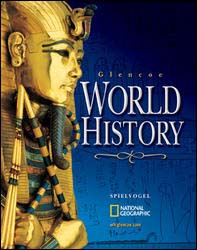Glencoe World HistoryChapter 5:
Rome and the Rise of Christianity, 600 B.C.– A.D. 500Chapter OverviewsRome began as a small village and became the seat of power of one of the greatest empires the world has known. The Romans were greatly influenced by early settlers of the peninsula and by the peoples whom they conquered. They were also innovators in art, culture, engineering, and government. Through warfare, they gradually conquered the entire Mediterranean and much of Europe. While at first Christians were persecuted, eventually Christianity was declared the empire's official religion. Power shifted to Constantinople, the empire's new eastern capital, as Rome declined. Section 1 The Rise of Rome
Geography greatly influenced the development of Rome. The narrow Italian peninsula was an important crossroads, and farmland was plentiful. Rome itself was strategically situated inland on hills along the Tiber River. In the late sixth century the Romans overthrew the Etruscan kings based north of Rome and established a republic. Wealthy patrician landowners in the Roman Senate dominated the early republic. Male nonpatrician Romans, called plebeians, voted and served in the army, but they could not marry patricians or be elected. Rome never became a democracy, but it did develop universal standards of justice that have influenced many societies. Over several centuries, Rome brought most of Italy under its control. It then confronted its main rival in the Mediterranean, Carthage. In the Third Punic War, Rome finally defeated Carthage. By the end of the war, Rome dominated the Mediterranean Sea. Section 2 From Republic to Empire
By the second century B.C., a few aristocrats dominated the Roman state. Meanwhile, many small farmers could no longer compete and became landless poor. Some leaders called for land reform to address the problem. However, the aristocrats resisted such pressures, and the republic faced a period of civil war. The First Triumvirate placed power in the hands of three wealthy generals. One of these generals, Julius Caesar, marched on Rome with his troops, and eventually he was declared dictator. Caesar's rule ended in his assassination. Following a Second Triumvirate, Octavian became Emperor Augustus, and the civil wars came to an end. The Roman Empire expanded its borders until, at its height, it had a population of more than 50 million. Trade and commerce thrived, but farming remained the chief occupation. Large landed estates called latifundia dominated farming, and an enormous gulf separated rich and poor in Roman society. Section 3 Culture and Society in the Roman World
The Romans imitated Greek culture in some respects, but they also developed their own realistic style of sculpture, introduced the use of concrete in construction, and displayed impressive feats of engineering in their roads, bridges, and aqueducts. Unlike the Greeks, Romans raised their children at home. Education was a father's responsibility. In early Rome the male head of household had absolute authority over the family. By the third century B.C., this authority was waning. Women could ask for a divorce and enjoyed increasing independence and a more visible—if unequal—social role. Slavery was commonplace, although slaves occasionally revolted. In the most famous case, a revolt of 70,000 slaves lasted two years before being crushed. The small town of Rome grew into a thriving, overcrowded city. There was an enormous gulf between the city's rich and poor. Yet Rome's public buildings, public works, and public entertainment provided a sense of grandeur and magnificence. Section 4 The Development of Christianity
Christianity emerged at a time of widespread unrest in the Roman province of Judaea. Jesus gained some followers among the Jews of Judaea. Yet Jews were split on how to respond to Jesus. A Jewish court denounced him and turned him over to the Roman authorities, who saw Jesus as a potential revolutionary. Jewish followers of Jesus saw him as the Savior. Christianity thus began as a religious movement within Judaism that caught on quickly following Jesus' death. Paul of Tarsus, a Jewish Roman citizen, preached the gospel to Jews and non-Jews throughout Asia Minor and along the coast of the Aegean. Romans, despite a history of tolerance of many religions, viewed Christianity as a threat to the state, and Christians often faced persecution. In the fourth century, the emperor Constantine proclaimed official tolerance of Christianity, setting the stage for its adoption as the empire's official religion. Section 5 Decline and Fall
Conflict and confusion followed the death of Marcus Aurelius, the last of the five good emperors. Invasions, civil wars, and plague brought the empire to the brink of economic collapse. Diocletian and Constantine restored at least temporary stability to the empire by using a combination of reforms, coercion, and tight controls on prices, vocations, and other aspects of life in the empire. Diocletian deemed the empire too large for one emperor and divided it into four units, each with its own ruler. The Greek city of Byzantium became the capital of the eastern part of the empire, while invading Germanic tribes put increasing pressure on the western part of the empire. Later Rome was sacked by two invading tribes, first the Visigoths, then the Vandals. The western emperor, Romulus Augustulus, was deposed by the Germanic head of the army, marking the fall of the Western Roman Empire.  | 

















